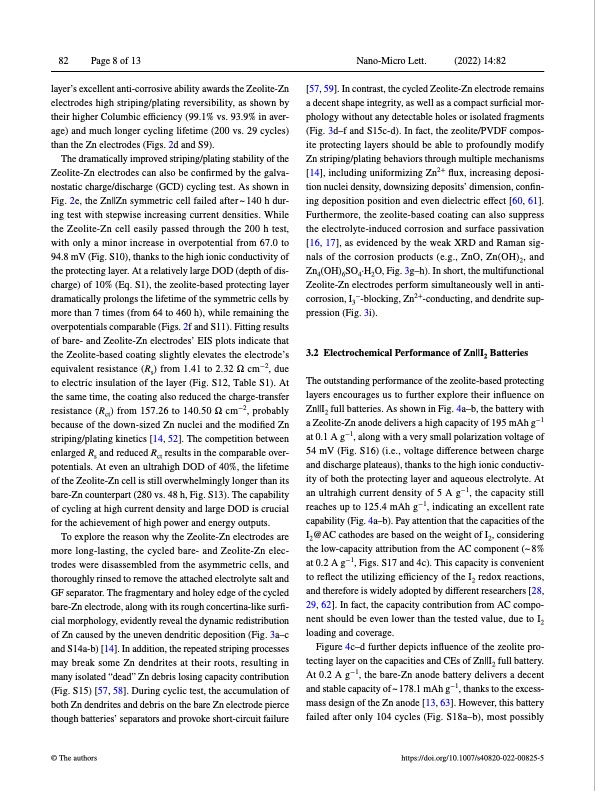
PDF Publication Title:
Text from PDF Page: 008
82 Page 8 of 13 layer’s excellent anti-corrosive ability awards the Zeolite-Zn electrodes high striping/plating reversibility, as shown by their higher Columbic efficiency (99.1% vs. 93.9% in aver- age) and much longer cycling lifetime (200 vs. 29 cycles) than the Zn electrodes (Figs. 2d and S9). The dramatically improved striping/plating stability of the Zeolite-Zn electrodes can also be confirmed by the galva- nostatic charge/discharge (GCD) cycling test. As shown in Fig. 2e, the Zn||Zn symmetric cell failed after ~ 140 h dur- ing test with stepwise increasing current densities. While the Zeolite-Zn cell easily passed through the 200 h test, with only a minor increase in overpotential from 67.0 to 94.8 mV (Fig. S10), thanks to the high ionic conductivity of the protecting layer. At a relatively large DOD (depth of dis- charge) of 10% (Eq. S1), the zeolite-based protecting layer dramatically prolongs the lifetime of the symmetric cells by more than 7 times (from 64 to 460 h), while remaining the overpotentials comparable (Figs. 2f and S11). Fitting results of bare- and Zeolite-Zn electrodes’ EIS plots indicate that the Zeolite-based coating slightly elevates the electrode’s equivalent resistance (Rs) from 1.41 to 2.32 Ω cm−2, due to electric insulation of the layer (Fig. S12, Table S1). At the same time, the coating also reduced the charge-transfer resistance (Rct) from 157.26 to 140.50 Ω cm−2, probably because of the down-sized Zn nuclei and the modified Zn striping/plating kinetics [14, 52]. The competition between enlarged Rs and reduced Rct results in the comparable over- potentials. At even an ultrahigh DOD of 40%, the lifetime of the Zeolite-Zn cell is still overwhelmingly longer than its bare-Zn counterpart (280 vs. 48 h, Fig. S13). The capability of cycling at high current density and large DOD is crucial for the achievement of high power and energy outputs. To explore the reason why the Zeolite-Zn electrodes are more long-lasting, the cycled bare- and Zeolite-Zn elec- trodes were disassembled from the asymmetric cells, and thoroughly rinsed to remove the attached electrolyte salt and GF separator. The fragmentary and holey edge of the cycled bare-Zn electrode, along with its rough concertina-like surfi- cial morphology, evidently reveal the dynamic redistribution of Zn caused by the uneven dendritic deposition (Fig. 3a–c and S14a-b) [14]. In addition, the repeated striping processes may break some Zn dendrites at their roots, resulting in many isolated “dead” Zn debris losing capacity contribution (Fig. S15) [57, 58]. During cyclic test, the accumulation of both Zn dendrites and debris on the bare Zn electrode pierce though batteries’ separators and provoke short-circuit failure Nano-Micro Lett. (2022) 14:82 [57, 59]. In contrast, the cycled Zeolite-Zn electrode remains a decent shape integrity, as well as a compact surficial mor- phology without any detectable holes or isolated fragments (Fig. 3d–f and S15c-d). In fact, the zeolite/PVDF compos- ite protecting layers should be able to profoundly modify Zn striping/plating behaviors through multiple mechanisms [14], including uniformizing Zn2+ flux, increasing deposi- tion nuclei density, downsizing deposits’ dimension, confin- ing deposition position and even dielectric effect [60, 61]. Furthermore, the zeolite-based coating can also suppress the electrolyte-induced corrosion and surface passivation [16, 17], as evidenced by the weak XRD and Raman sig- nals of the corrosion products (e.g., ZnO, Zn(OH)2, and Zn4(OH)6SO4·H2O, Fig. 3g–h). In short, the multifunctional Zeolite-Zn electrodes perform simultaneously well in anti- corrosion, I3−-blocking, Zn2+-conducting, and dendrite sup- pression (Fig. 3i). 3.2 Electrochemical Performance of Zn||I Batteries 2 The outstanding performance of the zeolite-based protecting layers encourages us to further explore their influence on © The authors https://doi.org/10.1007/s40820-022-00825-5 Zn||I full batteries. As shown in Fig. 4a–b, the battery with 2 −1 a Zeolite-Zn anode delivers a high capacity of 195 mAh g at 0.1 A g−1, along with a very small polarization voltage of 54 mV (Fig. S16) (i.e., voltage difference between charge and discharge plateaus), thanks to the high ionic conductiv- ity of both the protecting layer and aqueous electrolyte. At an ultrahigh current density of 5 A g−1, the capacity still reaches up to 125.4 mAh g−1, indicating an excellent rate capability (Fig. 4a–b). Pay attention that the capacities of the I2@AC cathodes are based on the weight of I2, considering the low-capacity attribution from the AC component (~ 8% at 0.2 A g−1, Figs. S17 and 4c). This capacity is convenient to reflect the utilizing efficiency of the I2 redox reactions, and therefore is widely adopted by different researchers [28, 29, 62]. In fact, the capacity contribution from AC compo- nent should be even lower than the tested value, due to I2 loading and coverage. Figure 4c–d further depicts influence of the zeolite pro- tecting layer on the capacities and CEs of Zn||I2 full battery. At 0.2 A g−1, the bare-Zn anode battery delivers a decent and stable capacity of ~ 178.1 mAh g−1, thanks to the excess- mass design of the Zn anode [13, 63]. However, this battery failed after only 104 cycles (Fig. S18a–b), most possiblyPDF Image | Boosting Zn Battery by Coating a Zeolite‐Based Cation‐Exchange

PDF Search Title:
Boosting Zn Battery by Coating a Zeolite‐Based Cation‐ExchangeOriginal File Name Searched:
Shang2022_ZnI-Battery.pdfDIY PDF Search: Google It | Yahoo | Bing
CO2 Organic Rankine Cycle Experimenter Platform The supercritical CO2 phase change system is both a heat pump and organic rankine cycle which can be used for those purposes and as a supercritical extractor for advanced subcritical and supercritical extraction technology. Uses include producing nanoparticles, precious metal CO2 extraction, lithium battery recycling, and other applications... More Info
Heat Pumps CO2 ORC Heat Pump System Platform More Info
| CONTACT TEL: 608-238-6001 Email: greg@infinityturbine.com | RSS | AMP |